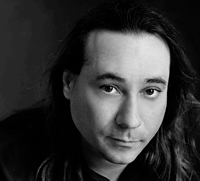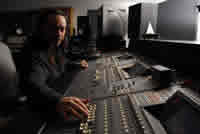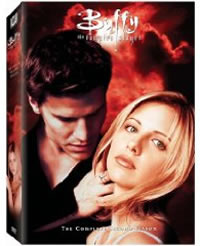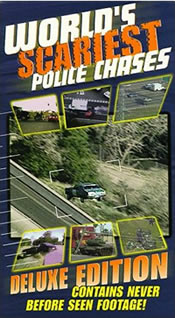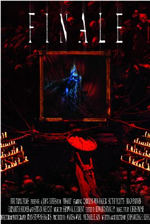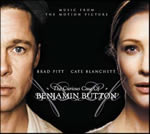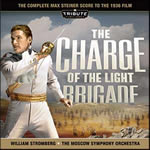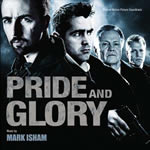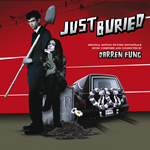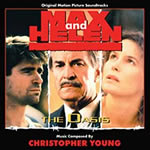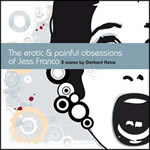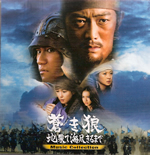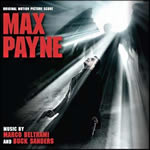 |
Soundtrax: Episode 2009-2
February 12th, 2009By Randall D. Larson
Shawn Clement Reality Bytes
From Reality TV to The Physics of Outer Space: The Musical Journey of Shawn ClementFor many years, composer Shawn Clement has defined the musical style for scoring reality television, with his propulsive scores driving the energy of shows like Scariest Police Chases or building up the dramas behind American Idol. But he started out scoring episodic television with shows like Buffy The Vampire Slayer and Batman: Rise of Sin Tzu, and now he’s the sound producer and composer for a big-budget science fiction feature called Quantum Quest. This film scoring is an ambitious 3-D, computer animated, large format, action-adventure film that interweaves animated sequences with actual space imagery captured from seven ongoing NASA and NASA/ESA space missions. Quantum Quest takes place in an atomic world, where the forces of the Core and the forces of the Void battle for the fate of the universe. The film unites astronaut Neil Armstrong with sci-fi icons from film and television. It boasts an all-star cast including sci-fi film icons Chris Pine, Samuel L. Jackson, Hayden Christensen, Amanda Peet, Robert Picardo, Brent Spiner, James Earl Jones, William Shatner, and Mark Hamill.
I interviewed Shawn on January 27th, just as he was sitting down to begin writing his score for Quantum Quest. We discussed his intentions for the forthcoming movie, and then took a look at his early work and examined just what made music for reality TV shows tick.
Q: Quantum Quest sounds like a really interesting production. How did you get involved in that show?
Shawn Clement: I had met the guy who wrote and created the project, Harry Kloor, through mutual friends, years ago when I was doing Buffy the Vampire Slayer. Harry was a big fan of the show, and my friend said ‘hey, my friend does the music, you guys should get together.’ So we became really good friends and he had this project that he was gestating. Harry’s like a scientist, he’s got a dual PhD in chemistry and physics, and NASA has approached him about creating an educational way to teach kids about physics. That’s kind of where the germ of this whole thing came about. Meanwhile he became a writer and he was writing for Star Trek Voyager and things like that. So he came up with this whole project and it became bigger than initially it was supposed to be, and he got all these really good people attached. It took a few years for him to get financing, but when the whole thing got green lit he called me and said ‘ok, we’re doing this, and I need you to put together the whole post package!’ Uh, okay! So now it wasn’t just about me doing the music and the songs, which is still primarily my creative function, but it was pulling in a great team. I just started calling on resources, people I’ve worked with throughout the industry and people that I’ve known but we’ve never had the opportunity to work together. It was finding the best solution and seeing who wants to do this. That’s kind of how it started.
Q: Where are you on the project now?
Shawn Clement: Right now I am starting to score, I’m starting to write. We record in April at Skywalker. I‘m also doing a couple of songs for the film and we’re talking with a couple of different people to come on board to sing and play and co-write. Those aren’t locked in yet so I can mention them, but it’s really exciting.
Q: As you are viewing the project at this point, what kind of approach are you looking for, musically?
Shawn Clement: The cool thing is, although it’s a science fiction film, the core of the movie is action-adventure. It’s about this young guy’s journey trying to find out what his real purpose is in the universe. The main character, Dave, is actually a proton, and you have the good forces and the bad forces and this battle. It’s actually an action/adventure film. Some of the visuals are amazing. They’ve got a lot of images from NASA that they’re incorporating into the film. So there’s a lot to draw on. They let me run with it. Harry’s the kind of guy who really trusts what I do, so he’s like, ‘look you’re on this for a reason, and I know that you know what to do here.’ He had a few specific suggestions like ‘make sure you get that’ or ‘I want that theme there.’ I’m trying to look at it as almost like a mini-Star Wars, and that’s really exciting. I’m just getting into it now and figuring out what the main character themes are, but keeping the fun in the action stuff too. It’s a wild ride, it’s non-stop music, and then incorporating the songs in a way that makes sense.
Q: I assume, recording at Skywalker, it’ll be a large orchestral based score?
Shawn Clement: Yeah. We’re using 82 pieces, and we’ll be having additional synths, too. But it’s definitely going to be more orchestral in nature. Two of the songs are more song-like, and the other one is actually a combination of score and song, and that one will be a combination of orchestra as well as a contemporary vibe. Originally we were going to license some tunes, but I really kept pushing for having something that’s specific to the movie. I felt that would work better for the film. I’m not really a fan of just throwing songs in there anyway, and that’s what going to be cool about these tunes, they’re really going to be tailored for this film.
Q: A song people know takes them out of the picture because they recognize the song…
Shawn Clement: There are times when that totally works, don’t get me wrong, but especially in a film like this, it really doesn’t serve the film well. The songs won’t get done until after the score is done, and we don’t dub the movie until June.
Q: They’re still shooting for a September release?
Shawn Clement: That’s what I’m told. It’s screaming!
Q: In science fiction, the music helps sell the reality of a very unreal science fiction environment. How would you say you’re doing that score-wise in this project?
Shawn Clement: We did a spotting session up at Skywalker with the sound designers, and it’s interesting because while it is a science fiction movie, I’m almost ignoring the fact that we’re in space. It’s kind of like, once again, and I hate to keep using this as an analogy, but it’s kind of like when you’re looking at Star Wars. It’s a sci fi film but it wasn’t scored like it was science fiction, it was just a story.
Q: It could have been a seafaring swashbuckler.
Shawn Clement: Exactly. That’s been my approach, although there are going to be certain themes where we acknowledge that, such as a scene where he goes inside the Cassini probe. But in terms of sound design – the other interesting thing about this film is that we’re in a fantasy world, because we go down to the sub-micro level with these protons. This is where it gets really interesting, because you have all these space ships and all that, but they’re actually organic, they’re not machines, so it’s a natural thing. So you think it’s all high-tech stuff, but when you think about it, these are actually organisms – the spaceships are actually organic material, so that’s been interesting to start thinking about how we’re going to come up with sounds for that. The way it relates musically is that this is not necessarily sci-fi. It is and it isn’t. It’s a weird line to walk. So the way I’m approaching it is that it’s purely story-based, and I’m letting the imagery, which is what I usually do as a film composer anyway, really inspire me as to what is going to happen. So I’m not going to get all weird and electronic, although I do want to find a place to use a Theremin!
Q: Oh yeah!
Q: So just how do you musically characterize the film’s main hero, which a photon?
Shawn Clement: We talked a lot about Dave. What I’m thinking with him is that he starts out young and then he becomes a mature guy, although he doesn’t become a full adult. But he has all these like self doubts, and he finds what his real purpose is. He could be anything. It’s exploring his growth.
Q: I guess the other element of this film is that it can’t be too wildly fantastic because it’s also got to be educational, because you want to be very real on the science that they’re doing here.
Shawn Clement: That what’s really cool about the way the story reads and the way the film is laid out. It is educational but it’s never thrown in your face like “ok kids, get you’re books out.’ You just get sucked into the story and the characters, but at the same time you are learning about this stuff.
Q: Did that aspect affect the musical style at all?
Shawn Clement: I’m not even thinking about it! If I start thinking that way I think it will really throw me a bad curve ball. I don’t think it needs to. The way it’s written, it already does its job. It’s pretty wild. There are a couple sections where there’s some dialog that is explaining things, but it does it in such a cool way. It’s really neat. I was really fascinated on how they were able to do that but keep it entertaining.
Q: What has been most challenging for you, at this point anyway, on this project?
Shawn Clement: Up to this point, since I really haven’t started doing any real heavy writing yet, it’s really been about putting the whole project together. I’ve never been asked to put together a whole post audio team, so it’s been working at a different level. I had to think about things I normally wouldn’t have to think about. It’s a good learning experience, and it also starts just making you think different in general. I wouldn’t say difficult, but it’s been a challenge, because it’s I’ve never had to deal with this! Now I’m really involved with all the aspects.
Q: How would you describe some of the steps you had to take to do that?
Shawn Clement: The first thing is really understanding what these other jobs do. I mean, we all kind of know what the sound designer does, or what this guy does or that guy does, and we all have the same budgets and things like that. But when you really start messing with this you really begin appreciating everybody’s needs. You’re almost working as a producer. It’s really interesting, because you really have to pay attention: hey this guy’s really going to need this, he’s going to need this assistant, and for him to do his job it relates to this, and is all of this realistic? And then you’re getting it all down to the final details and everything, and it’s just fascinating. Like the last couple of weeks we’re dealing with a lot of technical stuff, like what frame-rate we want to work at, what conversions we want to do. Normally, I just write the music and let those guys worry about it! Now I’m deeply involved. It’s complicated but at the same time I’m glad I’m doing it because it makes me think about different things. Now I understand why these processes happen, and why you might make different decisions. I get to know all these people in a much better way, and it just makes for a better experience. Plus, moving forward, it opens up other possibilities.
Q: I wanted to touch back on a couple other things you’ve done earlier in your career. When you first started out, you were doing some science fiction TV series like The Ray Bradbury Theater and, as you mentioned, Buffy. What were some of those earlier experiences like for you?
Shawn Clement: What’s interesting, talking about mostly Buffy – and this relates to how this film is working for me now. There you had a fantastical story. Think about it – it’s a vampire slayer, right? Kind of ridiculous, right? But the thing about that story, it wasn’t really about vampires, it was about this young girl who’s empowered, basically, and it really turned out to be a drama series. Of course there were scary moments and things like that, but it was very much a drama show. It was a young teenage girl going through all this normal teenage girl stuff. She just happens to kill demons now and then! Ok, that part’s a little weird! But it was a blast as a composer! It was total fun, because you did get to explore a lot of things. It wasn’t like, okay: I’m always just going to do chase music here or I’m always going to do this kind of music. You were literally open to do a lot of things. Also on that show I did songs as well; that’s something I’ve done a lot throughout my career. I came from a background of playing in bands and all of that. So I got to wear both hats. Not initially, but there was an episode where they had found a song I had done for a movie, they temped it in, they ended up writing a whole scene around it, and they had no idea I did songs, and after that happened, Joss was like, ‘dude, if you’ve got any more songs, let’s do that!’
Q: One of the things music did in Buffy was to bring the heart out of that show. It’s not all scary/spooky, it’s about real people.
Shawn Clement: Exactly. And that was the wildest thing about it. I remember when I first got on the show – I was on the second season, and I hadn’t really watched the first season. A friend of mine was one of the stars of the show, and that’s how I got on the show. I didn’t know too much about it. I remember seeing the movie version, and I was like, oh, no way…! And so when I finally got into it I thought wow, this is really cool. I started reading the scripts, and the show actually plays more like a film anyway. It was just very cool stuff.Q: How were the episodes assigned between you and Chris Beck and some of the other people who were involved?
Shawn Clement: That season they were alternating episodes. If there was a two-parter, then obviously you would do both parts, though. I think there were a couple two-parters that season.
Q: The other element that you’ve kind of focused on since the late ’90s is reality TV. What are the unique challenges for music in that kind of a scenario?
Shawn Clement: Reality television has changed a lot in the last couple of years, because now you have these competition shows. Those aren’t the kind of things I’ve done. When I started doing those first reality shows, the approach was very much – you have these clips, live footage of these chases and these crashes, and there’s some drama there. The idea was, the approach for me was, it’s got to be like a movie. Let’s really make this like a movie. The challenge was, it’s scored to picture, wall-to-wall. And you have four or five days to do 45-minutes of music, so right away you had a challenge. Budgets are always tight, especially with TV, but then they’re even tighter because there’s even less money there for reality TV shows. The budgets were actually bigger ten years ago than they are now. The first shows I started doing was World’s Wildest Police Videos and World’s Scariest Police Chases, and the creator of that show was a really cool guy and kind of a pioneer since he kind of started that whole craze. But it was interesting when we were trying to find out how he wanted to do the scenes. Once again, I’ve got to say I was really lucky, because he basically said ‘well you do what you do – do it.’ And that was great. He gave me a lot of freedom, but he did have some things to suggest, such as here we are doing this action chase music, and he didn’t want any horns and he didn’t want to hear any percussion. So I’m going, ‘okay, well, what the hell are we gonna do?’ It was a matter of figuring out what that really meant, because, obviously, I used all of that stuff. But it was coming up with what’s going to work, what would make him happy but drive that show, because the music really does drive the show. If you pull the music out of all those shows, a big element’s missing. So that was the approach: this is a movie, and right now we’re watching a scene from a movie. The other part of it is, say you’ve got a one-minute clip or a three-minute clip, each one of those is like a mini-move, so you have to ratchet everything up really fast. You’re going to have a beginning, middle, and end, but it’s all quick. So it’s a lot of dense writing, it’s a lot of music, and there’s no time. I’ve done a lot of shows, and I’ve got four shows I’m doing right now. I’ve been doing it long enough now where it’s kind of like, ‘Yeh, I’ve got it, I’ve got it.’ The popularity of these shows hasn’t waned. Those things are all over the world.
Q: How would you contrast say, a clip show like Police videos, with more of a reality show like, American Idol or something like that where you don’t have that kind a thing…
Shawn Clement: Those are different. On American Idol, for instance, 90% of the music in there is the people singing their songs, and then you have your theme, and it’s kind of a variety show. The only time when you’re really thinking about the emotional aspect of the underscore is either when you have the music for: ‘are they getting tossed?’ or when they’re doing little packages, like a little bio on one of the performers, and that’s when you want to get into score mode. I look at that package, and go, okay, we’re dealing with this person’s life and you score it almost like an episode of a soap opera.
Q: And super-heighten whatever drama may be there…
Shawn Clement: Exactly. I mean, other types of reality shows, like when you have a lot of these competition shows now, a lot of that music’s not even done to picture. They have libraries and they just literally chop it in. I’m not really a fan of that. Obviously if somebody wants to use my music – hey, great. I’m not going to argue with you! But I really come from the world of: I want to score the scene. I guess that maybe makes my approach to reality television a little different from most guys, because I want to score everything to picture, because to me that’s what makes – that’s film music. That’s what really makes music work with picture, because you can finesse things and you can detail things. It’s those subtleties that can really make that score do its function.
Q: Now in addition to that, you’ve also scored feature films. You did three last year, including an interesting horror film called Finale. How would you describe your score to that film?
Shawn Clement: Scary! That was an interesting project. It was an independent film from a first-time filmmaker, super-talented guy. I saw the film, and I thought it was a really happening film! And then when he told me how he actually made it, I said, wow, you’ve got to be kidding me! But I saw a lot of ability, and I think he’s someone who’s going to be doing a lot of stuff and moving forward. That’s something I like to do a lot, I like to work with new guys that I think who really have the ability to go somewhere, and you get to go run with them! But, on Finale, he had some really interesting ideas. He was into all the 1970s Italian horror films, and some of the music is just way out, and I could see that in the way he shot the film. But then, so I asked him, ‘well that’s cool, but what is it you like about me – because, I mean, I’m not doing that! I can, but that’s not what I usually normally do.’ There’s this argument about what horror music’s supposed to be, and I come from the world of old horror movies when they were actually really scored; nowadays you’ve got a lot of these droney, synthesized, almost sound-design elements. I don’t prefer that. I’ll do it, of course, but I don’t prefer that. And I think that’s why he liked me, he said ‘you score them like the old horror movies.’ And that was when we really started to connect. The film played like a real movie, because it was shot in the older style – it likened itself to a Rosemary’s Baby or something like that, so I got to really write some really scary music, orchestral based. There’s two songs in the movie, they’re more like source cues. One of them was mine and one of them was, ironically, from Buffy – a girl’s listening to it on headphones. It was a quick project, once again; tight deadline, tight money, but I was really happy with the final result.
Q: What was your style to create musical horror when needed to amp up the film’s scarier moments – or were you focusing on the human aspects of the story?
Shawn Clement: The thing about horror is: it’s what you don’t see that scares you most. And of course when it is scary I think you should knock them over the head. But horror, to me, is just creating that constant mood of being scared, but not giving it away. One of the best examples of that, and I always use this example, and if you watch The Omen, there’s a scene where the mom falls off the banister, and what’s interesting about that scene is that it’s all scored before that happens. The little kid’s running around the room on a tricycle, and Goldsmith gets the music building up, and there’s all this stuff and then it all stops. It gets completely quiet and he’s just riding his little bike and you hear the squeak-squeak-squeak-squeak, and he hits the table, she falls off, and there’s no music there. And then after she falls, the music comes back in. It’s so damn scary – it’s what he set up at the beginning, and he left that hole, and that, to me, is the best way how that stuff works. It’s what you do before and after, you don’t necessarily have to do that right on the spot. That’s how I approached this movie. It’s really funny – most of my jobs I’m the wall-to-wall music guy. And I am totally not a fan of that! I believe it what’s actually right for the film. I don’t think you need to have wall-to-wall music. It’s like that old joke, it’s what you don’t play. It’s really true. I don’t care what genre you’re in or what, it’s sometimes it’s what you don’t say that makes all the difference. There was a scene I remember scoring when I was on Buffy. I used to always lead up to a scary part, and I was doing one scene and Joss goes, ‘you know what? Don’t even give us a hint. When that guy jumps out, just hit it then.’ And I went, ‘oh, okay!’ And, boom, it was so much better! And it really stuck in my head that that was definitely the way to go, and it made a lot of sense to me.
For more information on Finale, see: www.finalethemovie.com
For more information on Quantum Quest, see: www.qqthemovie.com
New Soundtrax in Review
Concord Records has released Alexandre Desplat’s sublime, wistful, and transcendent musical design for The Curious Case Of Benjamin Button. For David Wincher’s moving metaphysical fantasy about a man living life biologically in reverse, Desplat, already noted for the fragile lyricism he has invested in prior scores, has come up with an enchanting score that floats, wafting above the storyline like a tangible sunrise, aglow with a buoyant brightness, always in constant motion. That idea of movement coincides with Benjamin’s journey, aging backwards through time, and although the music is moving forward, the score stays fairly unobtrusive, a sustained flash shining down on the character, a sense of spirit driving the character on despite the bizarre occurrence happening to him. A separate but similarly inspired love theme resonates with a poignant melancholy as the doomed love story plays out, along with a keyboard-driven motif associated with “ticking time” that keeps the idea of the passage of time – with inevitable oblivion at either end – continuously if hauntingly in mind. Its fragile poignancy and suspended airiness informs the film with a sensation of wonder that inspires the storyline and defines its affecting sensibility. Concord’s soundtrack houses Desplat’s score on one disk, and a second disc containing source cues (13 – jazz, classical, period tunes) and dialog extracts (10) from the film.
Tribute Film Classics’ latest release is a striking restoration of a splendid Max Steiner score, from the 1936 adventure epic, The Charge of the Light Brigade, directed by Michael Curtiz (Casablanca. Previously issued only in part, Tribute presents the complete score, gloriously restored and magnificently performed by the Moscow Symphony. The music is a massive composition and a difficult performance, but it’s wonderfully rendered here, restored to its full-blooded glory by John Morgan and conducted with all its passion and power by William Stromberg. “It includes some of the most difficult music to perform on both the technical and interpretive levels,” said Morgan, who reconstructed the orchestral score from Steiner’s original sketches. “Steiner wrote long sweeping music that followed the action and dramatic needs of the film.” The score is an excellent example of Steiner’s brilliant capacity of shifting moods on a dime. One of the score’s best cues, “Massacre/A Debt Is Paid,” begins with a massive conflagration of dissonant orchestral fury that suddenly evaporates into a lyric of such fragile poignancy, and then rages to life again with a virtuoso blur of activity from the string section, only to disapparate anew into drum-driven fragrance wafting on air. The score’s main theme is derived from a military march, appropriate for the film’s subject matter (a highly fictionalized account of a British cavalry major who nobly leads his soldiers into ‘the valley of death’ to avenge women and children massacred by a local rajah allied to the Russian forces against whom the British are fighting during the Crimean War’s Battle of Balaclava, on October 25, 1854). Steiner has never been more complicated in his arrangements of themes and motifs or his energized orchestration, and listening to the score in such a finely restored rendition is simply amazing; it roams through so many feelings, from its sensitive love theme to its sheer exuberance (“Geoffrey Bids Farewell/Trek to Buy Horses” is a marvelous example of both expressions), its driven momentum, the vivid clatter and hoofbeats of its propulsive main theme, to the astonishing clarity of its thematic interaction. The score’s highlight, the nearly 10-minute cue that accompanies the final “charge” that gives both film and historical occurrence its name, is a cataclysmic operation the equal of a major military battle in musical terms, with battalions of strings and horns and winds and percussions sweeping down in uniform order, engaging an enemy with stalwart violence and melodic honor. The album includes an extensive booklet with illustrated notes on the film and its music, as well as the complete text of Alfred Lord Tennyson’s poem of the same name, which served as the film’s inspiration.
Another Steiner score of note, also a historical epic, was recently released by FSM. John Paul Jones, a problematic 1959 swashbuckler from producer Sam Bronston starring Robert Stack as the Revolutionary War naval hero, featured as leitmotif-integrated a score as Charge of the Light Brigade, but with more opportunities for a lighter tone. The original soundtrack source being lost, FSM provides the premiere CD release from a remastering of the score album recording (a separate recording of the score by the Sinfonia of London, conducted by Muir Mathieson, and issued on LP concurrent with the film’s release). The album’s dozen tracks were a faithful rendering of Steiner’s score as it appeared in the film, replete with all manner of references to budding Americana folk tunes, as well as French and Russian music influences (as Jones interactions with these countries or their representatives figure in the storyline). Aside from these statements and motifs, and plenty of dynamic swashbuckling battle music, the score is characterized by a marvelous romantic waltz (“Aimee”) associated with the beautiful French woman whom Jones falls in love with. This motif will carry Jones across the seas and bolster his confidence even when she becomes lost to him. It’s an intricately lovely theme, performed by solo and massed violins in Steiner’s finest poignancy. “The Surrender” is the score’s strongest theme, furious battle music building to a dramatic peak as Jones triumphs over the British commander (Peter Cushing). Regrettably the full version of this music as it appeared in the film has been lost to time (perhaps a full length reconstruction of the score would be a project for Tribute Film Classics at some future time?) The cue “Valley Forge” is also a standout, the intense somber music heard after Jones delivers his resignation to George Washington and walks through the encamped and tattered Continental Army. FSM’s release provides the full score LP on CD for the first time, and pairs it with another Steiner score, Delmer Daves’ 1961 drama, Parrish, intended as a follow-up to Daves’ 1959 hit, A Summer Place (also very successfully scored by Steiner), a domestic drama about love and lust and a young man named Parrish McLean (Troy Donahue) growing up on a tobacco plantation in the Connecticut River Valley. Steiner provided a number of character themes, very tuneful and pretty, orchestral renditions of each make up the soundtrack material on the album. For the “soundtrack” album, Steiner re-recorded his music in a more commercially favorable light, so what we essentially have is a tuneful “themes” album, seven selections oriented around the film’s very pretty romantic themes which made up Side 1 of the LP issued at the time of the film’s release. The second side contained “piano concertos” of Steiner’s themes, performed by pianist George Greeley. This was during the day when record companies felt listeners only wanted the “easy listening” music, so the dramatic music from the film was left off and to make up a saleable LP, “theme” interpretations filled out the album. In this case, we have five tracks of Greeley performing piano arrangements of three cues from the film and two other Steiner themes (Gone With the Wind and A Summer Place). These interpretations are in typical Ferrante and Teicher style of the day; despite his extensive performance career on motion pictures and on records, Greeley is better remembered as a composer for his music for the TV series My Favorite Martian and others. His tracks here are nicely but overly lush and a little overly commercial easy-listening. The album includes insightful notes by James Lochner about the making of each film and its music. Both scores, in their film interpretations are excellent works and highlight Steiner as a master of melody and thematic integration.
Mark Isham’s score for Pride and Glory, released on CD by Varese Sarabande, wafts over Gavin O’Connor’s intensely dramatic story about a multi-generational family of New York City Police officers tested when a corruption investigation centers on one of their own members. As Isham does so well, he subliminally evokes the dynamic existing between characters and paints it in broad, if ethereal, strokes into his score. The music for Pride and Glory is executed with layers of tonality, driven by pounding and persistent drums and synth percussion, punctuated by acoustic guitar and other elements. The score remains unobtrusive and quietly commentative until its final pair of cues, when it grows in power and crescends to a powerful and meaningful resolution. The score is almost minimalist in its execution, as chords grow and shift and sway and build, its power generated by the eloquence inherent in its progressing strains and dark, tonal grains. It maintains a very dark and almost dismal atmosphere. The closing cue segues into a moving rap spoken over Isham’s concluding rhythmic riff, an indictment against inaction in the midst of corruption and impropriety: “the waterline is rising and all we do is stand there; the waterline is rising and all we do is stand there.” I don’t generally like rap or hip-hop, but it works well in this setting, and with Isham’s fluent progressive chord structure giving it a harmonic backing instead of the typical beatboxing of most urban rap, it assumes a powerful coda that informs a poignant summation of the story as it concludes.
MovieScore Media has released Darren Fung’s “ironically cheerful” for score the award-winning Canadian dark comedy Just Buried. The music was recorded by the Czech FILMharmonic Orchestra in Prague and makes prominent use of the harpsichord to create an unusual atmosphere that combines quirkiness with elegance. Just Buried is a Comedy of Terrors-ish story about a young bank who inherits a nearly bankrupt funeral home from his estranged father. He falls in love with the alluring young mortician, only to find out she's offing people to keep the place in business. The music is a highly flavorful, zesty arrangement, rather Thomas Newmanesque in its prevalent use of quick, lightly punched keyboard, but the film also has a more dramatic orchestral face (the severe orchestral chords clusters of “I Dropped a Minivan On Him” and the severely accusatory histrionics of “You Screwed My Dad?”) as well as a quirkier side (the happy whistled tune of “Fortunes Are Changing” or the discomforting heaviness of “Damned Prostrate” and “I Have To Pee”). It’s a very enjoyable score that never takes itself too seriously and revels in its ability to have a fun time.
My hosts here at BSX have released an excellent score by Christopher Young, Max and Helen, a sublimely intimate score for Philip Saville’s 1990 television drama starring Treat Williams, Alice Krige, and Martin Landau. Based on the book by noted Nazi hunter Simon Wiesenthal (played by Landau in the movie), the story focuses on a pair of Holocaust survivors unearthed by Wiesenthal as he builds a case in 1962 against former labor camp Commandant Werner Schultze. Max and Helen (not their real names) were engaged to be married when arrested and sent to prison camp. Max managed to escape and years later learned that Helen survived; but at a cost: her child is Schultze’s. In order to protect this family from further pain and suffering, Wiesenthal for the first time drops his prosecution against Schultze. The impassioned story was given a beautiful score for orchestra and voice; except for one location-enhancing cue, Young avoids the temptation to rely upon Hebrew musical traditions as many Holocaust-related film scores have done, instead composed a haunting, lyrical main theme for voice over strings and piano. The solo soprano voice lends a persuasive ambiance to the motif that wraps the story in an eloquent expression of feeling. Chopin’s delicate “Piano Etude #3 in E” forms a secondary theme that is presented in several tracks, representing past times enjoyed by the couple, the memory of which inform both Max and Wiesenthal as they confront the reality of Helen and her son. Young delineates the labor camp, Zalesie, with an oppressive rendering of dark atonality that apparatus out of his main theme to form a mélange of sound clusters evoking the torturous conditions at the work camp, a sonority that is imbued with an atmosphere of foul wickedness and vile suffering; reverberated musique concrete sounds of clacking train wheels, black-smelling locomotives chugging past, whimpering cries lend a harsh reality to the flashback scene (listen to this, Bishop Williamson). It’s a moving and affecting score and one of Young’s most tender, an ode to survival and to capitulation in submission of a better good. The score, previously issued on CD by Bay Cities in 1991 and out of print for some time, is paired with a previously unreleased Young score from 1984, very early in his career, for the psychological drama, The Oasis. Young’s fourth score after a pair of horror films (The Dorm That Dropped Blood, The Power) and a comedy (Highpoint), The Oasis is a much more austere animal than Max and Helen. The film told of nine strangers who survive an airplane crash in the Mexican Baja, focusing on each’s reaction and attitude toward survival. Like the horror films Young had already experienced and would soon master as a composer, his score embodied a distinctly psychological approach, moving from the explicit external story as the film opens to the much more disturbing, implicit psychological story as the film plays out. The score opens with a slight Latin tonality to its sumptuously beautiful orchestral Main Title, strings supplemented by a variety of primitive percussion (log drums, conch shells, bottles, rattles). The tonal lyricism of this theme and “Mache Mirage” is soon overcome by the more pervasive atonality as the film ventures into psychological territory, and Young’s underscore becomes the darker psychological renderings of each character’s internal monolog. It’s a brutal and often dissonant approach but a fascinating fusion of sound design and subliminal musical dramaturgy (the nearly 9-minute long “Devil’s Food” is a disturbing and brilliantly severe exercise in atonal sound progression).
Orange Mountain Music has released the soundtrack album for director Scott Hicks (Shine, No Reservations) documentary film about Philip Glass, Glass: A Portrait of Philip in Twelve Parts. For 18 months Hicks followed Glass around with a video camera capturing all aspects of his life. His film provides an intimate look at Glass as a family man, delves into his spiritual life, and produces some insights on how he composes music. The soundtrack contains much of the music from the film including a wide variety of music from every part of Philip Glass’s career, including selections from Einstein on the Beach (the 1984 BAM Production), Etoile Polaire, Glass’ music for solo piano, and more. The music included is not Glass’ film music, although some of it is drawn from the same grain, but the music becomes film music in the context of Hicks’ documentary, capturing a new flavor as it is heard in this filmic context. The music also provides a fair survey of Glass’ work (including one film score, a track from the 1988 Errol Morris documentary, The Thin Blue Line) on one disc. Unique to this recording is a live piano performance by Glass of his “Metamorphosis No. 2,” shot on camera by Hicks and concluding the album as an audio piece. This is an excellent overview of Glass’ work, varying from his more characteristic minimalist rhythm-based work such as “Floe,” which very much resembles his music from Koyaanisqatsi and its sequel films, to his more avant-garde choral work from Einstein on the Beach and his shriller material from the 2006 album, Analog (nee North Star). It tend to favor the former filmic material over the harsher work, but consider A Portrait of Philip in Twelve Parts a unique musical biography in which the subject’s own works are provide to paint that sonic portrait. It’s a very likeable collection and interpretation of the artist as a musical voice. www.orangemountainmusic.com
All Score Media has released a superlative collection of early 1980s exploitation film music from Austrian composer Gerhard Heinz with The Erotic and Painful Obsessions of Jess Franco. Compiling a trio of scores for Franco’s stylish and exotically flavored (s)exploitation cinema, 1980’s Eugenie (Historia De Una Perversion) (aka in Germany Lolita am Scheideweg), and 1981’s Die Nacken Superhexen Vom Rio Amore (Naked Super Witches of the Rio Amore, aka Linda) and Die Säge Des Todes (Bloody Moon). The former is a return for Franco to his oft-visited de Sade period (1979’s Justine and the Whip, 1975’s Eugenie, 1970’s Eugenie 1970, and 1969’s Marquis de Sade: Justine). The 1980 film featured a breezy score with elements of light jazz/pop and lounge, from the cool chorale paunchiness of “Wieder am Swimmingpool” to the bass-and-percussion riffing of “Alba und Lolita” and the, um, fairly unique masterbatorial lullaby “Lolita und der Teddybär, the strings over finger-chimes and drum vibe of “Gespräch am Vorhang” and the compelling organ and keyboard melody of “Der Traum – zweite Phase, an especially appealing tune. It’s a very likable score with inventive orchestration and pleasing performances. The original Spanish film had featured music from Daniel White; Heinz was hired to score the German version with a new score, culling it together mostly from previous works. The gory giallo, Bloody Moon, contrasted some really eerie horror music with a variety of disco and samba tunes; several examples of each type are presented here, including a suite of suspenseful tunes and the spooky “Bungalow 13” with its frantic, ghostly soprano over relentless rhythmic strings and drums. Linda contains probably the album’s loveliest score, featuring a variety of pleasing tuneful pop melodies, including a gorgeous piece for piano and strings in “Betsy und Ron” and a very Morriconesque cue, “Die Mächem in Kloster” with alluring its mix of keyboards and voices. The album includes short notes from Heinz on scoring Eugenie and from actress Katja Bienert on her memories from Eugenie and Linda, and a short interview with Heinz, all in both English and German. All but one cue on the album are previously unreleased. www.allscore.de
Taro Iwashiro’s massive and eloquent score for Aoki Ôkami: chi hate umi tsukiru made (Genghis Khan: To The Ends of the Earth and Sea; released on Region 1 DVD last year by Funimation) is available on a lavish soundtrack from Avex Entertainment of Japan. The music for Shinichirô Sawai’s epic retelling of the life of the famous Asian conqueror features a full-blooded orchestral score by Iwashiro, whose recent scores for large-scale Japanese historical epics (Red Cliff, Shinobi: Heart Under Blade, Azumi) have demonstrated his skill with massive orchestrations. Genghis Khan displays plenty of massive orchestral muscle but also a contrasting degree of intimacy as the great conqueror’s character is peeled back to explore the man beneath the legend. Iwashiro provides a melodic, thematic musical accompaniment that is rich in orchestral depth and flavor. The music is alternatively thunderous, passionate, and invigorating. Iwashiro scores battle scenes with an aggressive forward momentum, while his graceful melodies underline character interactions and reflection. In addition to nine tracks of score, the album includes the closing song performed by singer Mink, and seven additional songs or new age tunes tracked at the end of the CD, plus a DVD disc containing a (non-subtitled, Region-2 playable) extended video trailer about the film.Lakeshore Records has issued Nico Muhly’s intimate score for The Reader, a post-WWII drama from director Stephen Daldry (The Hours) in which, nearly a decade after his affair with an older woman came to a mysterious end, law student Michael Berg re-encounters his former lover as she defends herself in a war-crime trial. Muhly is a newcomer to filmscoring; this is his sixth score since 2005, and garnered him a nomination for Breakout Composer of the Year from the International Film Music Critics Association. The score is a quiet and reflective one, appropriate to a film which is mostly about reflection, about past affections emerging into new implications and the inner turmoil this enacts within the characters. Emphasizing piano, winds, and strings, the understated score makes its commentary quietly but persuasively, through yearning passages and hesitant melodies the music wraps itself around the characters and conveys their shared intimacy, apartness, and misgivings, as well as the conflicts embodied by the circumstances surrounding their reunion. A very nice score.
Max Payne, the movie, was marred by a derivative, pointless, and moronic storyline that tried to make a meaningful film out of a point-and-shoot video game but couldn’t come up with a single original idea; even the point-and-shoot moments were spoiled by redundant directorial style and haphazard filming. Only the cast (especially Mila Kunis, Ludacris, and Olga Kurylenko) and the score, a collaboration between Marco Beltrami and Buck Sanders (a co-producer and composer of additional music on several of Beltrami’s prior scores), maintained a degree of interest and integrity. The score, released on CD by La-La Land, is an intriguing collaboration between Beltrami’s orchestral sensibilities and Sander’s synthesizer wizardry. Director John Payne had told the composers he wanted a simple musical motor that would keep the emotionally dead Max going on his hunt for the killers of his wife and child; the only sense of melody would be associated with Max’s memories of his murdered wife and son. The score embraces these sensibilities directly, with the noted duality between the hybrid, rhythmic, and grinding action and driving material and the more acoustic, reflective melodic material. By detuning a piano down an octave, Beltrami creates a haunting and disturbing sonority for the main character that perfectly captures his desultory and fatalistic personality (“Payneful Piano”). The score shares the film’s monochromatic visualization of Max’s world, with a stark and industrial tonality that keeps it pretty solidly within a certain tonal and texture range. In many ways, the score is a dirty score – meaning that Beltrami intentionally had his acoustic instruments dirtied down through gravely synth renderings or processing to make them fit the gritty, unreal world in which the film exists. Rhythmic progression and texture (“Colvin Quivers,” “Window Payne”) give the film what propulsion it is able to generate, often paired with a melody line that enhances the music with a strident sense of power and proportion (“Storming the Office,” “Factoring Max”) elsewhere a rotary-blade percussive riff beats the rhythm into a staccato stroboscopic cadence and becomes the motor that drives the otherwise deadened investigator (“Max Attacks,” “Investigation,” “Vote for Dennis,” “Max Marches On”). Quieter moments (“No Respects for You,” “Max Returns Home,” the especially eloquent “Dark Haven”) proffer a degree of character introspection and depth, with “Heaven To The Max” proffering the score’s loveliest melodic interpretation as Max envisions an impassioned reunion with his lost family in the afterlife. If you liked the film you should find the score equally persuasive; if you didn’t care for the film, give the score a tryout all the same, it’s a powerful and driven piece of work.
Film Scoring NewsWinners for the 36th ‘Annie’ Awards were announced in Los Angeles last week, with the International Animated Film Society awarding the bulk of its honors this year to DreamWorks’ hit Kung Fu Panda, including that for music – with Hans Zimmer and John Powell winning the prize for feature music as well as that for short animation, for the short film Secrets of the Furious Five, which featured characters from Kung Fu Panda). www.annieawards.org
Austin Wintory (winner of the Audience Award in 2008 at Sundance for Captain Abu Raed) will score The River Why, which stars William Hurt and Amber Heard and will open in late 2009.
British composer James Brett is currently scoring the upcoming animated sci-fi comedy Planet 51. Brett’s previous credits include Gladiator spoof Gladiatress, last year's UK horror film Outpost and the new TV series Crusoe. – via upcomingfilmscores.com
Henry Jackman will step out from behind the “additional music by” moniker (Vantage Point, Kung Fu Panda, Dark Knight) to compose the score to Dreamwork’s new Monsters Vs. Aliens, opening next month.
Soundtrack NewsiTunes has made available one track of Tyler Bates’ score for Watchmen, along with one of the songs from the film, a striking version of Bob Dylan’s “Desolation Row” performed by My Chemical Romance. Both it and the Bates track, “Prison Fight” are available as individual download (fine the score track by searching for “Tyler Bates” – it won’t come up it you just search for “Watchmen,” oddly). The full songtrack and score soundtrack will be available for download, or on CD from Reprise Records, on March 3rd.
New releases from Varese include Brian Tyler’s “strikingly beautiful and hypnotic” music from The Lazarus Project, an eerie thriller from writer John Glenn (Eagle-Eye) who makes his directorial debut with this film; and Marcelo Zarvos poignant music for the HBO Desert Storm drama, Taking Chance. Both are scheduled for release on Feb 17th. The label released the soundtrack to Tom Tykwer’s (Run Lola Run) new thriller, The International, last week, containing a gripping score by Tykwer, Johnny Klimek, and Reinhold Heil.Italy’s GDM Records will release a limited edition (500 copies) of Ennio Morricone’s music for Giordano Bruno, a 1973 French-Italian co-production directed by Giuliano Montaldo and starring Gian Maria Volontè and Charlotte Rampling. The film tells the last years of life of the Nolan philosopher Giordano Bruno until his killing in 1600, burnt alive after being denounced of heresy by the Inquisition. “The dark abyss between sacred and profane is well outlined in music by Ennio Morricone: intense pieces of religious choral music alternating to suggestive atonal themes that highlight instead the scientific side of the protagonist, lived in a society always believer of the occult and always read to the witches hunting due to the dominant Inquisition.” RCA released an album in stereo (RCA OLS 21) during the film’s release, but only recently stereo masters of the recording session were found which gave GDM the chance to present the complete edition of this soundtrack with the inclusion of alternate tracks not previously issued.
Also announced from GDM is the score to La morte non ha sesso (aka “A black veil for Lisa") a 1968 giallo directed by Massimo Dallamano and starring Sir John Mills, Luciana Paluzzi ,and Robert Hoffmann is a thriller that stylistically could be placed between certain Mario Bava and early Dario Argento movies heavy on atmospheres and stylism. The score includes a bossa version of the main theme featuring the voice of Edda Dell’Orso.
Harkit Records has released John Barry’s score for 1974’s adventure film, The Dove, for the first time on legit CD (a bootleg was issued by Artemis in 2001). Harkit's CD replicates the 1974 ABC soundtrack LP, enhanced by a fully-illustrated booklet that describes the making of the film and its score.
Koch Records will release Bruno Coulais’ score to the 3-D stop-motion animated movie Coraline digitally on February 3rd, and in stores on February 24th, 2009. Focus Features will release the movie in 3-D and regular [2-D] theaters) on February 6th. The movie combines the visionary imaginations of two premier fantasists, director Henry Selick (The Nightmare Before Christmas, James and the Giant Peach) and author Neil Gaiman (Sandman, Stardust), Coraline is a wondrous and thrilling adventure that honors and redefines two moviemaking traditions. It is a stop-motion animated feature – and, as the first one to be conceived and photographed in stereoscopic 3-D, unlike anything moviegoers have ever experienced before.
MovieScore media has released digitally the soundtrack to one of the most successful Norwegian films ever, World War 2 action thriller Max Manus. Directed by Joachim Roenning, the film tells the true story about one of the most brilliant saboteurs during the war, portrayed by Aksel Hennie. The original orchestral music for the film is composed by one of Norway's leading film composers, Trond Bjerknes, who penned an accurately dark and exciting score accompanying the suspense and drama of the film - and the inner conflicts experienced by the film's hero. Bjerknes' previous scores include Swedish action hit Hamilton and the Norwegian horror film Dark Woods.
Also available for download and on CD is Ryan Shore’s score for Shadows, is the new film by Academy Award-nominated director Milcho Manchevski (Before the Rain) and it's a mysterious drama with thriller elements telling the story about the son of a famous physician. Shore’s orchestral score for Shadows provides a dark and restrained emotional accompaniment to the film's story, where the esoteric performances of vocal soloist Janita gives the film and score a unique sound. MSM previously released Shore’s soundtracks to Jack Brooks: Monster Slayer, Numb, and The Girl Next Door (the latter via Film Music Downloads).
Games Music News
Sumthing Else Music Works, Inc. will release on Feb. 17th Halo Wars™ Original Soundtrack featuring the original music score from the action strategy game for the Xbox 360 developed by Ensemble Studios.
The 2-disc soundtrack features over 50 minutes of original score from the popular Halo Wars game. The music was composed by Stephen Rippy (Age of Empires series, Age of Mythology) with performances by the FILMharmonic Orchestra and Choir Prague. The second disc is a DVD with nine additional bonus tracks, nine 5.1 mixes of tracks from the music disc, two cinematic trailers, and one behind-the-scenes video. “For Halo Wars I wanted to write music that fit both the size of the story and its sense of discovery,” said Rippy. “Each of the various worlds in the game feels a little different; each of the main characters brings something to the mix. More than anything else, it was important that these tracks fit comfortably into the existing Halo universe. I hope they’ll take the listener to some new places as well.”
Randall Larson was for many years senior editor for Soundtrack Magazine, publisher of CinemaScore: The Film Music Journal, and a film music columnist for Cinefantastique magazine. A specialist on horror film music, he is the author of Musique Fantastique: A Survey of Film Music from the Fantastic Cinema and Music From the House of Hammer. He now reviews soundtracks for Music from the Movies, Cemetery Dance magazine, and writes for Film Music Magazine and others. For more information, see: www.myspace.com/larsonrdl
Randall can be contacted at soundtraxrdl@aol.com

